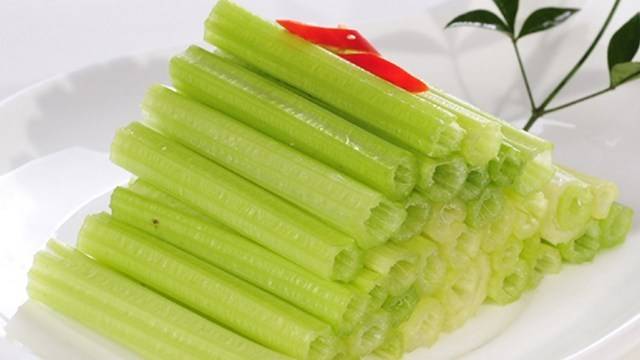Hypertension, this is a well-known issue, and it is a cardiovascular disease with a high incidence rate among middle-aged and elderly people in winter, which has a significant impact on the health of patients and can seriously endanger life.
Currently, drug therapy is a basic measure to control and stabilize blood pressure. In addition to this, hypertension is closely related to daily diet. Many foods have a natural hypotensive effect. However, many friends may not know about this. Here are 10 common foods for natural blood pressure reduction. Eating more of these in daily life can help stabilize blood pressure!
10 Common Foods for Natural Blood Pressure Reduction
1. Celery
The hypotensive effect of celery may be well-known to many friends. Celery is rich in protein, carbohydrates, and vitamins. Its hypotensive effect mainly comes from apigenin, bergapten, and volatile oil in its stems and leaves, providing functions such as lowering blood pressure, reducing blood lipids, and preventing and treating atherosclerosis.
2. Onion
Onion is the only vegetable known to contain prostaglandin A. Prostaglandin A not only dilates peripheral arteries and lowers peripheral vascular resistance but also counteracts vasoconstrictor substances in the body, thereby reducing blood pressure. Therefore, regularly consuming onions has a good preventive effect on cardiovascular diseases.
3. Black Fungus
Black fungus is a flavorful fungus with high nutritional content and is known as the “meat among vegetables”. It is particularly high in iron, making it a healthy food for anemia in middle-aged and elderly people. Additionally, the adenosine nucleotides in black fungus have a significant inhibitory effect on thrombus formation, making it a hypotensive food for middle-aged and elderly people.
4. Kiwi
Kiwi, also known as kiwifruit, is highly nutritious, containing magnesium and potassium, which can help blood vessels expand normally, improve hypertension, and reduce cholesterol absorption, improving symptoms of hyperlipidemia and arteriosclerosis, thus inhibiting hypertension.
5. Hawthorn
Hawthorn, also known as Shanlihong, is a common dietary food for cardiovascular diseases in middle-aged and older people. It is rich in various organic acids, vitamins, minerals, and hawthorn ingredients, which can help eliminate excess fat in the body, dilate blood vessels, and play a role in reducing blood pressure and blood lipids. The most common dietary method is to soak hawthorn in water and drink it.
6. Bamboo Shoots
Bamboo shoots are the young shoots of bamboo and are a common dish in households due to their delicious taste and crispy texture. From a dietary perspective, bamboo shoots are low in fat, low in sugar, and high in fiber. Eating bamboo shoots can promote intestinal motility, aid digestion, help eliminate food stagnation, and prevent constipation, making them very suitable for people with hypertension and promoting longevity.
7. Garland Chrysanthemum
Garland chrysanthemum was a royal delicacy in ancient times, known as the “emperor’s vegetable”. In terms of nutrition, garland chrysanthemum contains various amino acids, proteins, and high levels of sodium, potassium, and other mineral salts, which can regulate water metabolism in the body, promote urination, relieve edema. Additionally, it contains a volatile essential oil, choline, and other substances, which have hypotensive and brain-boosting effects.
8. Apple
In the West, there is a saying “An apple a day keeps the doctor away”, indicating its effectiveness in preventing and treating diseases. Apples are rich in potassium, which can dilate blood vessels and prevent hypertension. Additionally, they contain pectin and flavonoids, which have effects on preventing and treating arteriosclerosis.
9. Purple Sweet Potato
Purple sweet potato contains anthocyanins with natural antioxidant effects. Anthocyanins can prevent over 1000 diseases. The anthocyanins in purple sweet potatoes can significantly inhibit the oxidation of low-density lipoprotein and the aggregation of platelets, which are the main causes of atherosclerosis. Therefore, eating purple sweet potatoes regularly also has a good hypotensive effect.
10. Tomato
Tomatoes are fruits in the vegetable category and are one of my favorite foods. They contain moderate sugars (glucose and fructose), vitamin P, and have an effect similar to aspirin, reducing blood viscosity, protecting blood vessels, preventing hypertension, and having a good effect on preventing coronary heart disease.
5 Dietary Taboos for Hypertension
1. Avoid High Salt: The more salt intake, the higher the blood pressure level. Reducing salt intake leads to a decrease in blood pressure, and the incidence of stroke and coronary heart disease also decreases. Therefore, avoiding high salt has many benefits!
2. Avoid Smoking and Drinking: Smoking and alcohol can easily stimulate the body, raise blood pressure, so it is recommended that hypertensive patients avoid alcohol.
3. Avoid High Fat: Consuming too much fatty foods will increase the body’s fat and cholesterol content excessively, which is very detrimental to preventing and controlling hypertension.
4. Avoid Overeating: Obesity is the primary risk factor for hypertension. Overeating can lead to obesity, so dietary adjustments should be made.
5. Avoid Monotony: Dietary diversity can supplement the body with multiple nutrients. Daily diets should include the appropriate protein, coarse and fine grains, and increase the intake of fresh vegetables and fruits.
[Guess the Chinese medicinal herb]
[Riddle] Long Chili
.
.
.
.
.
【Answer】 Xixin


